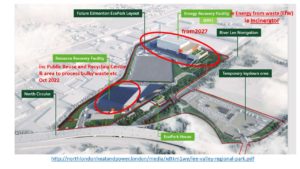Assumptions underpinning the North London Waste Authority plans for the replacement Edmonton Incinerator

The North London Waste Authority (NLWA)’s plans for the new Edmonton incinerator, make these assumptions – disputed below:
- Incinerating organic waste releases zero carbon emissions.
- Defra waste legislation will fail to reduce non-recyclable waste arisings, and that waste volumes will actually continue to increase.
- Removing recyclables from black bags – that the machinery for this, being sold, and in operation now, does not work
- UK Grid decarbonisation – that this will not happen, so the UK current gCO2/kWh can be used in calculations for the life of the incinerator
- Carbon Intensity Floor – That the Mayor won’t be able to take any action to rectify when emissions exceed his 300g CO2e/kWh floor.
- Cost of waste to feed incinerators – that this can be bought in at low cost when the new treatment streams need more waste than North London provides to keep them working
- Carbon Capture and Storage – that this will be available, will work and be economically viable and can be added to the plan
- Jobs – that the number of new local new jobs and apprenticeships provided by the incinerator will be significant.
- UK taxes on incineration – that these (eg Emissions Trading Scheme ETS) will continue to exclude electricity from waste incineration.
- Non Regulated pollutants – that recent research indicating serious health risks can be discounted
- Heat to Enfield, Haringey and Hackney – that this would be low carbon and is a prioritised aim of the project
Further information per point and the risks of the assumptions (these should be clearly stated in the Risk Assessments).
- Carbon emissions from biodegradables – It is common to quote the IPCC, where it states that ‘if incineration of waste is used for energy purposes, both fossil and biogenic CO2 emissions should be estimated. Only fossil CO2 should be included in national emissions under Energy Sector while biogenic CO2 should be reported as an information item also in the Energy Sector’ ( 5.8).
However, the IPCC also specifies that: ‘The approach of not including [biogenic] emissions in the Energy Sector total should not be interpreted as a conclusion about the sustainability or carbon neutrality of bioenergy’ (Q2-10). Moreover, sending 1 tonne of organic waste to incineration emits up to 50% more CO2e than sending it to anaerobic digestion (p. 12).
The emissions to be accounted for Nationally under other non energy categories are those prior to the disposal stage, including the growth stage (negative sequestration), transportation, packaging and collection stage. However emissions from biodegradables during the disposal stage do still emit carbon – high for incineration for electricity and heat but low for anaerobic digestion. Therefore emissions from food and garden waste must not be ignored. RISK: Discounting the biogenic emissions of energy-from-waste incineration allows erroneous calculations to be made in comparing anaerobic digestion against landfill against incineration causing excessive damage to our planet.
- Defra waste legislation – Government legislation has reached an advanced stage of legislation with a start date of 2023 for moving much ‘waste’ from incineration streams to be recycled (or digested for biodegradables), yet the expected significant reduction in residual waste has not been considered. RISK: that even before the incinerator is commissioned there will be very little volume to burn and the investment will be a white elephant.
- Recyclables from black bags – There are many examples of already working plants with similar capacity to Edmonton, and the waste mechanisation industry is geared up to focus more on this than incineration. Eg Oslo and Wijster RISK: that North London will remain unable to retrieve ‘waste’ that can be recycled rather than burnt.
- UK Grid decarbonisation – The Government’s Ten Point Plan is to increase low carbon electricity significantly, and investors and citizens are increasingly demanding that we have zero carbon electricity. RISK: That the UK will be unable to demonstrate leadership in decarbonisation in the lead up to COP26. Other countries are therefore more likely to delay – even as devastating weather events escalate catastrophically.
- Carbon Intensity Floor – Current calculations showing that the ceiling of 300g CO2e/kwh by 2030 demanded by the GLA can be met are theoretical and based on assumptions that are out of date. (Mayor of London p314) If this level is not met in practice Edmonton incinerator will continue to emit unacceptable levels of carbon emissions. RISK: As above excessive emissions are already causing adverse weather events.
- Cost of waste to feed incinerators – Currently Denmark buys in waste from the UK as it has overcapacity. The UK is also heading for a massive overcapacity so companies will be pushing up prices to buy in any waste available. RISK: Edmonton waste streams will have insufficient feedstock and not be viable, or will even burn recyclables.
- Carbon Capture and Storage – Although CCS is recommended by the Committee on Climate Change it is not an established technology and the cost has not been factored in to the Edmonton business case. RISK: That CCS will become mandatory for new incinerators and the cost for Edmonton would soar.
- Jobs – A small number of apprenticeships and jobs are planned at the Edmonton Eco Park. Recycling as much as possible would create many more jobs. RISK: The Edmonton incinerator will slow economic recovery and hinder North London job growth in the circular economy.
- Incineration tax, carbon charge, inclusion in Emissions Trading Scheme (ETS) – Unlike other facilities in the energy sector, energy-from-waste incinerators are not taxed on their CO2 emissions. The Government has specified that an incineration tax may need to be applied if waste targets are not met, and potential legal action or a policy change could lead waste incineration to be taxed on its own or within a regime, such as the UK Emissions Trading Scheme. RISK: That if tax is applied to energy from waste the business case for Edmonton costs will no longer be valid.
- Non Regulated pollutants – A growing body of scientific research demonstrates that ultrafine particles and other pollutants are associated with serious health risks. Eg Waste incineration and adverse birth and neonatal outcomes RISK: That people around Edmonton will suffer bad health or death. (and be able to prove this in court for damages)
- Heat to Enfield – The carbon intensity of heat from waste incineration is already four times higher than many alternative heat sources. As the grid decarbonises (p. 36), heat pumps and even individual electric heating will be much lower carbon. RISK: That households using heat from Edmonton in Enfield, Hackney and Haringey will incur higher carbon emissions and bills than alternative heat sources.
